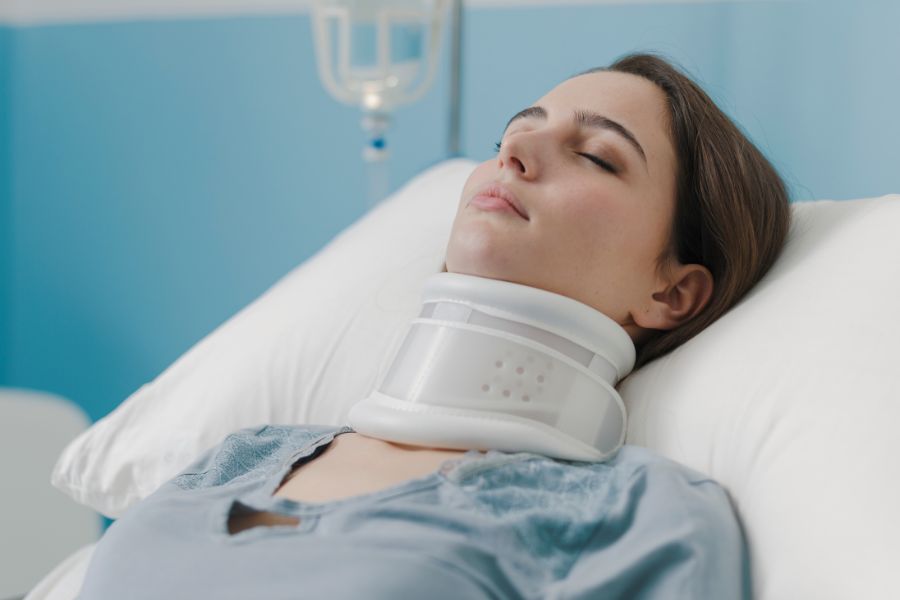Wondering how long it takes to fully recover from cervical disc replacement surgery? It’s natural to have questions when planning for a major procedure that promises to relieve chronic neck pain and restore mobility.
Knowing what to expect during each stage of the healing process can help you feel confident, stay patient, and make the best decisions for your health. Keep reading for a complete guide to recovery, helpful tips for healing, and advice on choosing the right surgeon for your procedure.

What is the Full Recovery Time for Cervical ADR Surgery?
Recovery from cervical artificial disc replacement (ADR) surgery typically takes about 3 to 6 months for most patients. However, the exact timeline can vary based on your health, activity level, and how closely you follow your surgeon’s recovery plan. Some patients may start feeling significantly better within a few weeks, while others require a longer recovery period to regain full strength and flexibility.
Artificial Disc Replacement Recovery Timeline
Recovering from cervical disc replacement happens in carefully staged phases. Each period focuses on healing, restoring mobility, and safely increasing your activity levels. Below, we break down what you can expect during each major stage of your recovery journey.

First 24-48 Hours: Immediate Healing
In the first 24 to 48 hours after cervical disc replacement surgery, patients are carefully monitored in a recovery room to ensure their vital signs are stable and the surgical site is healing properly. Mild neck stiffness and discomfort are common, and early movement of the arms and legs is encouraged to prevent stiffness and improve circulation. Pain management begins immediately, and patients are usually encouraged to start gentle activities with supervision to support a smooth transition to home recovery.
First 24-48 Hours

Hospital Stay (1-3 Days)
While not every patient requires an extended hospital stay, many remain in the hospital for one to three days after surgery for close monitoring and early recovery support. The focus during this period includes managing pain, assessing neurological function, and encouraging short walks to stimulate circulation. Patients who recover quickly and meet mobility goals may be discharged earlier. Before leaving, patients receive detailed instructions for caring for the incision site and guidelines for safe movement at home.
Hospital Stay

Week 1: Initial Home Recovery
The first week at home focuses heavily on rest and allowing the body to begin the healing process. Patients are encouraged to engage in short, light walks to promote circulation but must avoid lifting heavy objects, twisting the neck, or strenuous activities. Pain management is important during this phase, and following medication schedules and wound care instructions is critical. Most patients will also schedule their first postoperative check-up during this week to monitor incision healing and overall recovery progress.
Week 1

Weeks 2-4: Gradual Activity Increase
During the second week through fourth, patients typically start to feel more comfortable and are encouraged to gradually increase their daily activities. Light household tasks and short walks are recommended, but it’s important to avoid high-impact activities or heavy lifting. Some patients may begin a guided physical therapy program during this time to help restore neck mobility and strength. Listening to your body and following your surgeon’s advice are key to making steady progress without risking setbacks.
Month 1

Weeks 4-6: Improved Mobility
By weeks four to six, most patients experience a noticeable improvement in neck mobility and strength. Discomfort continues to decrease, and many people feel ready to resume more normal daily activities, including returning to work if their job does not involve heavy lifting or intense physical demands. Gentle stretching exercises and physical therapy sessions may become a bigger part of the recovery plan during this stage, helping to rebuild flexibility and endurance without overstraining the surgical site.
Weeks 4-6

Months 2-3: Returning to Normal Activities
By months two to three, many patients are able to return to most of their normal daily activities with little or no discomfort. Light exercise, desk work, and moderate physical activities are often resumed during this time. However, patients should still avoid high-impact sports or heavy lifting unless cleared by their surgeon. Follow-up appointments are important at this stage to ensure the artificial disc is functioning properly and the spine is healing as expected.
Months 2-3

Months 4-6: Full Recovery for Most Patients
Between months four and six, most patients achieve full recovery from cervical disc replacement surgery. By this time, neck strength and mobility are significantly restored, and discomfort is usually minimal or completely gone. Patients can typically resume all normal activities, including more vigorous exercise routines and low-impact sports. Continuing to practice good posture and following any personalized rehabilitation plans helps ensure the long-term success of the artificial disc and overall spinal health.
Months 4-6

6 Months – 1 Year: Long-Term Spine Health
From six months to one year after surgery, the focus shifts to maintaining spine health and preventing future issues. Most patients have returned to full activity by this point, including more vigorous exercises if approved by their surgeon. Long-term success depends on maintaining good posture, staying active with regular low-impact exercises, and following any recommended lifestyle adjustments. Periodic check-ups may be scheduled to ensure the artificial disc remains properly positioned and functioning well.
Months 6-12
Patients Testimonials
Tips for Better Healing After Artificial Disc Replacement Surgery
Recovering successfully from cervical disc replacement surgery involves more than just waiting; it requires active participation and mindful habits. Following your surgeon’s instructions closely and supporting your body’s natural healing process can help you achieve the best possible results. Here are some important tips to guide your cervical disc replacement recovery journey:
- Follow your postoperative care instructions carefully. Stick to your surgeon’s guidance regarding medications, incision care, activity levels, and follow-up appointments.
- Stay active with gentle movements. Short, frequent walks help promote circulation, prevent stiffness, and speed healing without overstraining your neck.
- Prioritize good posture. Whether standing, sitting, or sleeping, maintaining proper posture reduces stress on the healing disc and supports spine alignment.
- Avoid heavy lifting and sudden movements. Protect your neck by steering clear of activities that involve strain, bending, or twisting motions until cleared by your surgeon.
- Eat a nutritious, balanced diet. Proper nutrition supports tissue repair and boosts your immune system during the healing process.
- Stay consistent with physical therapy. If prescribed, attending all therapy sessions and doing recommended exercises at home can significantly improve strength and flexibility.
- Report any unusual symptoms promptly. If you notice increased pain, swelling, numbness, or other concerns, contact your surgeon right away to address issues early.
Pain Management after Cervical Disc Replacement
Pain control is an important part of the recovery process after cervical disc replacement surgery. Managing discomfort properly not only improves quality of life but also helps promote faster healing. Patients should work closely with their surgical team to find the right balance of medications, lifestyle adjustments, and supportive care strategies. Here are some key approaches to managing pain effectively:
- Take prescribed pain medications as directed. Follow your surgeon’s instructions carefully regarding dosage and timing to stay ahead of pain rather than reacting to it.
- Use ice therapy in the early days. Applying ice packs gently to the surgical area can help reduce inflammation and numb localized discomfort.
- Gradually transition to over-the-counter medications. As healing progresses, many patients switch from prescription painkillers to options like acetaminophen or ibuprofen, with their surgeon’s approval.
- Practice gentle movement and walking. Staying mobile promotes circulation, reduces stiffness, and prevents some of the aches that come from inactivity.
- Focus on proper sleep positioning. Sleeping with good neck support and avoiding awkward positions can significantly minimize overnight pain.
- Monitor and report persistent or worsening pain. If pain doesn’t improve or becomes more intense, contact your surgeon promptly to rule out complications.
Potential Complications From The ADR Procedure
While cervical disc replacement surgery is generally safe and highly successful, as with any surgical procedure, there are potential risks to be aware of. Understanding these possible complications allows patients to be better prepared and to seek prompt care if necessary. Here are some potential complications to monitor for:
- Infection at the surgical site. Signs include redness, swelling, fever, or unusual drainage from the surgical incision.
- Artificial disc displacement or failure. Although rare, the artificial disk may shift or malfunction, sometimes requiring revision surgery.
- Persistent pain or nerve damage. In rare cases, nerve irritation or injury can cause ongoing symptoms despite surgery.
- Adjacent segment degeneration. Stress on the spinal discs above or below the replacement site may lead to wear over time.
- Difficulty swallowing or hoarseness. These symptoms can occur temporarily due to surgical manipulation near the esophagus and throat.
- Blood clots. As with many surgeries, there is a small risk of developing blood clots, particularly if mobility is limited after surgery.
Monitoring your recovery closely and attending all scheduled follow-up appointments with your surgeon helps ensure that any potential issues are addressed early for the best outcomes.

Best Neurosurgeon in Orange County
Dr. Taghva specializes in the treatment of neck pain, low back pain, sciatica, brain tumors, Parkinson’s disease, as well as other conditions requiring brain or spine surgery.

How to Choose the Best Spine Surgeon
Choosing the right spine surgeon is essential for ensuring the success of your cervical disc replacement. An experienced surgeon not only improves the chances of an optimal recovery but also significantly lowers the risk of potential complications. Spine surgeries require precise technique, thoughtful planning, and personalized care to ensure the best long-term outcomes. A skilled surgeon will guide you through each phase of recovery, minimizing risks and maximizing your chances for a smooth healing journey.
Dr. Alexander Taghva is a board-certified neurosurgeon who specializes in advanced spine surgeries, including cervical artificial disc replacement. Trained at Johns Hopkins University and the University of Southern California, Dr. Taghva is known for his expertise in minimally invasive techniques and neuromodulation therapies. His patient-focused approach and outstanding credentials make him the trusted choice for spine care in Orange County. Call us today at 949-388-7190 or visit our Contact Page to schedule your consultation.
